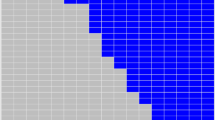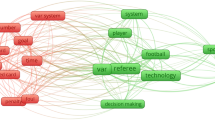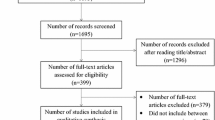Abstract
Sports offer interesting insights into demand due to the added twist of fan preferences for outcome uncertainty. We add to and amend previous work by analyzing the time series behavior of Major League Baseball attendance (1901–2003) using break point analysis, exploring a wide variety of measures of game uncertainty, playoff uncertainty, and consecutive season uncertainty. Only playoff uncertainty is statistically significant, and it is economically significant only for (1) truly ambitious intervention and (2) recent history. The policy implication is that actual league choices may be motivated by wealth redistribution rather than concerns over competitive balance.
Similar content being viewed by others
References
Baade R.A., Tiehen L.J. (1990) An analysis of major league baseball attendance, 1969-1987. Journal of Sport and Social Issues 14: 14–32
Bai J., Perron P. (1998) Estimating and testing lineal models with multiple structural changes. Econometrica 66: 47–78
Bai J., Perron P. (2003) Computation and analysis of multiple structural change models. Journal of Applied Econometrics 18: 1–22
Butler M.R. (1995) Competitive balance in major league baseball. American Economist 39: 46–52
Cairns J.A. (1987) Evaluating changes in league structure: The reorganization of the Scottish Football League. Applied Economics 19: 259–275
Canes M.E. (1974) The social benefits of restrictions on team quality. In: Noll R.G. (eds) Government and the sports business. Washington DC, Brookings Institution, pp 81–114
Coates D., Harrison T. (2005) Baseball strikes and the demand for attendance. Journal of Sports Economics 6: 282–302
Davies B., Downward P., Jackson I. (1995) The demand for rugby league: Evidence from causality tests. Applied Economics 27: 1003–1007
Dawson A., Downward P. (2005) Measuring short-run uncertainty of outcome in sports leagues: A comment. Journal of Sports Economics 6: 303–313
Demmert H. (1973) The economics of professional team sports. Lexington Books, Lexington, MA
Domazlicky B.R., Kerr P.M. (1990) Baseball attendance and the designated hitter. American Economist 34: 62–68
Eckard E.W. (2001a) Baseball’s blue ribbon economic report: Solutions in search of a problem. Journal of Sports Economics 2: 213–227
Eckard E.W. (2001b) Free agency, competitive balance, and diminishing returns to pennant contention. Economic Inquiry 39: 430–443
Eckard E.W. (2003) The ANOVA-based competitive balance measure: A defense. Journal of Sports Economics 4: 74–80
Fort R. (2006) Competitive balance in North American sports. In: Fizel J. (eds) Handbook of sports economics research. M.E. Sharpe, Armonk, NY, pp 83–106
Fort R., Lee Y.H. (2006) Stationarity and MLB attendance analysis. Journal of Sports Economics 7: 408–415
Fort R., Maxcy J. (2003) Comment: Competitive balance in sports leagues: An introduction. Journal of Sports Economics 4: 154–160
Fort R., Quirk J. (1995) Cross-subsidization, incentives, and outcomes in professional team sports leagues. Journal of Economic Literature 23: 1265–1299
Humphreys B.R. (2002) Alternative measures of competitive balance in sports leagues. Journal of Sports Economics 3: 133–148
Humphreys B.R. (2003) The ANOVA-based competitive balance measure: A reply. Journal of Sports Economics 4: 81–82
Hunt J.W., Lewis K.A. (1976) Dominance, recontracting, and the reserve clause: Major League Baseball. American Economic Review 66: 936–943
Jones J.C.H., Schofield J.A., Giles D.E.A. (2000) Our fans in the north: The demand for British Rugby League. Applied Economics 32: 1877–1887
Lee Y.H. (2004) Competitive balance and attendance in Japanese, Korean and U.S. professional baseball leagues. In: Fort R., Fizel J. (eds) International sports economics comparisons. Praeger Publishers, Westport, CT, pp 281–292
Lee Y.H., Fort R. (2005) Structural change in baseball’s competitive balance: The depression, team location, and integration. Economic Inquiry 43: 158–169
Levin R.C., Mitchell G.J., Volcker P.A., Will G.F. (2000) The report of the independent members of the commissioner’s blue ribbon panel on baseball economics. Major League Baseball, New York, NY
Neale W.C. (1964) The peculiar economics of professional sports. Quarterly Journal of Economics 78: 1–14
Noll R.G. (1974) Attendance and price setting. In: Noll R. (eds) Government and the sports business. Brookings Institution, Washington, DC, pp 115–158
Perron P. (1989) The great crash, the oil price shock, and the unit root hypothesis. Econometrica 57: 1361–1401
Rottenberg S. (1956) The baseball players’ labor market. Journal of Political Economy 64: 242–258
Schmidt M.B. (2001) Competition in major league baseball: The impact of expansion. Applied Economic Letters 8: 21–26
Schmidt M.B., Berri D.J. (2001) Competitive balance and attendance: The case of Major League Baseball. Journal of Sports Economics 2: 145–167
Schmidt M.B., Berri D.J. (2002) The impact of the 1981 and 1994–1995 strikes on Major League Baseball attendance: A time-series analysis. Applied Economics 34: 471–478
Schmidt M.B., Berri D.J. (2003) On the evolution of competitive balance: The impact of an increasing global search. Economic Inquiry 41: 692–704
Schmidt M.B., Berri D.J. (2004) The impact of labor strikes on consumer demand: An application to professional sports. American Economic Review 94: 334–347
Sloane P.J. (1971) The economics of professional football: The football club as a utility maximiser. Scottish Journal of Political Economy 17: 121–145
Sloane P.J. (1976) Sporting equality: A comment. Journal of Industrial Relations 18: 79–84
Szymanski S. (2003) The economic design of sporting contests. Journal of Economic Literature 41: 1137–1187
Team Marketing. (2007). Team Marketing Reports fan cost index, Major League Baseball, 2003. http://www.teammarketing.com/fancost/mlb. Last accessed September 18 2008.
U.S. House of Representatives. (1957). Organized professional team sports. Committee on the Judiciary. 85th Cong. 1st Session, Pt. 1, pp. 354–363.
Whitney J.D. (1988) Winning games versus winning championships: The economics of fan interest and team performance. Economic Inquiry 26: 703–724
Whitney J.D. (1993) Bidding till bankrupt: Destructive competition in professional team sports. Economic Inquiry 31: 100–115
Zimbalist A.S. (2002) Competitive balance in sports leagues: An introduction. Journal of Sports Economics 3: 111–121
Zimbalist A. (2003) Competitive balance conundrums: Response to Fort and Maxcy. Journal of Sports Economics 4: 154–160
Author information
Authors and Affiliations
Corresponding author
Rights and permissions
About this article
Cite this article
Lee, Y.H., Fort, R. Attendance and the Uncertainty-of-Outcome Hypothesis in Baseball. Rev Ind Organ 33, 281–295 (2008). https://doi.org/10.1007/s11151-008-9193-9
Published:
Issue Date:
DOI: https://doi.org/10.1007/s11151-008-9193-9




